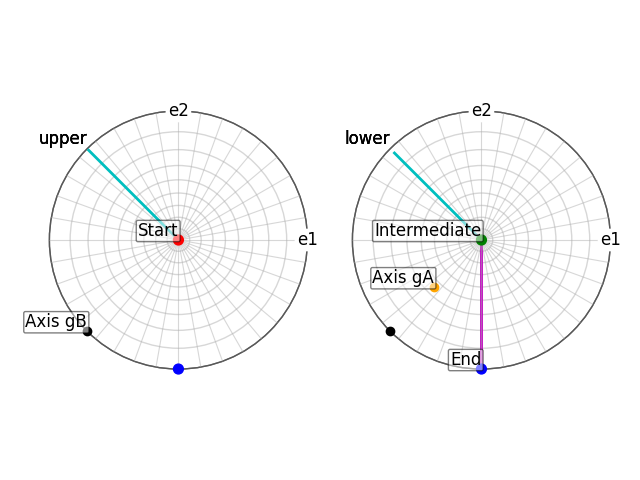Note
Click here to download the full example code
Combining rotations#
This example demonstrates how to combine two rotations \(g_A\) and \(g_B\), i.e. from left to right like so
This order follows from the convention of passive rotations chosen in orix which follows [Rowenhorst et al., 2015].
To convince ourselves that this order is correct, we will reproduce the example given by Rowenhorst and co-workers in section 4.2.2 in the above mentioned paper. We want to rotate a vector \((0, 0, z)\) by two rotations: rotation \(A\) by \(120^{\circ}\) around \([1 1 1]\), and rotation \(B\) by \(180^{\circ}\) around \([1 1 0]\); rotation \(A\) will be carried out first, followed by rotation \(B\).
Note that a negative angle when defining a rotation in the axis-angle representation is necessary for consistent transformations between rotation representations. The rotation still rotates a vector intuitively.

Out:
gA, gB and gAB:
* As quaternions:
Rotation (3,)
[[ 0.5 -0.5 -0.5 -0.5 ]
[ 0. -0.7071 -0.7071 -0. ]
[-0.7071 -0.7071 0. -0. ]]
* As orientation matrices:
[[[-0. 1. 0.]
[ 0. -0. 1.]
[ 1. 0. -0.]]
[[ 0. 1. -0.]
[ 1. 0. 0.]
[ 0. -0. -1.]]
[[ 1. -0. -0.]
[-0. 0. -1.]
[ 0. 1. 0.]]]
Point rotated by gAB:
[0, 0, 1] -> [-0.0, -1.0, 0.0]
import matplotlib.pyplot as plt
from orix import plot
from orix.quaternion import Rotation
from orix.vector import Vector3d
plt.rcParams.update({"font.size": 12, "grid.alpha": 0.5})
gA = Rotation.from_axes_angles([1, 1, 1], -120, degrees=True)
gB = Rotation.from_axes_angles([1, 1, 0], -180, degrees=True)
gAB = gA * gB
# Compare with quaternions and orientation matrices from section 4.2.2
# in Rowenhorst et al. (2015)
g_all = Rotation.stack((gA, gB, gAB)).squeeze()
print("gA, gB and gAB:\n* As quaternions:\n", g_all)
print("* As orientation matrices:\n", g_all.to_matrix().squeeze().round(10))
v_start = Vector3d.zvector()
v_end = gAB * v_start
print(
"Point rotated by gAB:\n",
v_start.data.squeeze().tolist(),
"->",
v_end.data.squeeze().round(10).tolist(),
)
# Illustrate the steps of the rotation by plotting the vector before
# (red), during (green) and after (blue) the rotation and the rotation
# paths (first: cyan; second: magenta)
v_intermediate = gB * v_start
v_si_path = Vector3d.get_path(Vector3d.stack((v_start, v_intermediate)))
v_sie_path = Vector3d.get_path(Vector3d.stack((v_intermediate, v_end)))
fig = plt.figure()
ax0 = fig.add_subplot(121, projection="stereographic", hemisphere="upper")
ax1 = fig.add_subplot(122, projection="stereographic", hemisphere="lower")
ax0.stereographic_grid(), ax1.stereographic_grid()
Vector3d.stack((v_start, v_intermediate, v_end)).scatter(
figure=fig,
s=50,
c=["r", "g", "b"],
axes_labels=["e1", "e2"],
)
ax0.plot(v_si_path, color="c"), ax1.plot(v_si_path, color="c")
ax0.plot(v_sie_path, color="m"), ax1.plot(v_sie_path, color="m")
gA.axis.scatter(figure=fig, c="orange")
gB.axis.scatter(figure=fig, c="k")
text_kw = dict(bbox=dict(alpha=0.5, fc="w", boxstyle="round,pad=0.1"), ha="right")
ax0.text(v_start, s="Start", **text_kw)
ax1.text(v_intermediate, s="Intermediate", **text_kw)
ax1.text(v_end, s="End", **text_kw)
ax1.text(gA.axis, s="Axis gA", **text_kw)
ax0.text(gB.axis, s="Axis gB", **text_kw)
fig.tight_layout()
Total running time of the script: ( 0 minutes 0.575 seconds)
Estimated memory usage: 9 MB